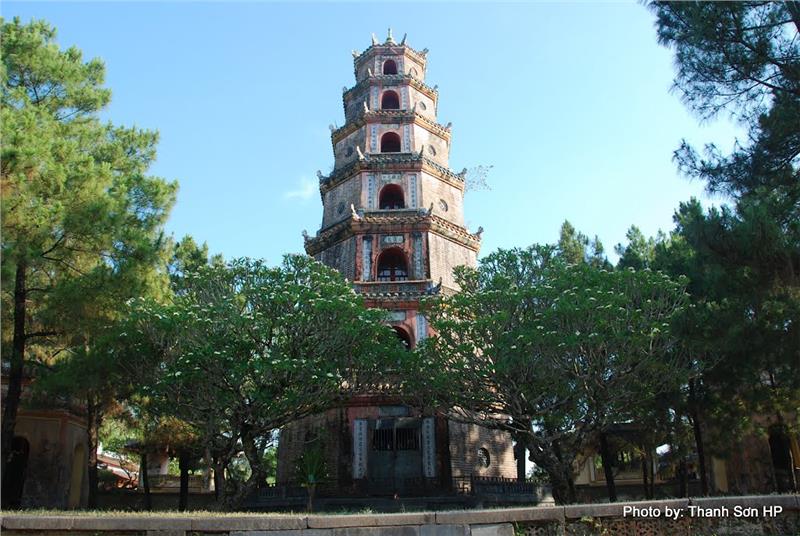Thien Mu Pagoda is worth one of the most mentioned beautiful landscapes in Hue. Not only does it go on romantic poems or Hue characterized lyrics, Thien Mu is also considered as a sacred pagoda and the sight not to be missed by any tourists when setting foot in the ancient capital.

Thien Mu Pagoda (also known as Linh Mu Pagoda) is located in Ha Khe hill, on the north bank of Perfume River, in Huong Long village. It is about 5 kilometers from Hue city, which is easy to reach from the city center. Built in 1601 for the order of the first Nguyen Lord, Nguyen Hoang, who at that time was the governor of Thuan Hoa (today known as Hue), Thien Mu Pagoda can be regarded as the oldest pagoda in Hue.
Thanks to the rise and heyday of Cochinchinese Buddhism, the pagoda had been rebuilt in a significant scale under Lord Quoc period - Nguyen Phuc Chu (1691-1725). Lord Quoc contributed a great 2-ton bell called Dai Hong Chung. The Lord then oversaw another series of major expansions and construction projects. Accordingly, the largest expansion phase in the pagoda's history in 1714, namely Thien Vuong shrine, Dai Hung shrine, shrines to the heavenly realms, the Jade Emperors, halls for preaching Dharma, towers for storing sutras, bell towers, drum towers, meditation halls and halls to venerate Avalokiteshvara...many architectural works of which no longer exist today. Lord Quoc also personally wrote and carved into a large stele (2.60m high and 1.2m wide) talking about the construction of buildings here. The stele was placed on the back of a huge stone turtle, decorated simple but extremely breathing.

With its natural beauty and its scale expanded since that time, Thien Mu Pagoda had become the most beautiful pagoda in Cochin. Through historical events, Thien Mu Pagoda were re-restored several times during reigns of Nguyen Emperors. Emperor Thieu Tri, who succeeded Minh Mang, erected Tu Nha Tower in 1844, which is now known as the Phuoc Duyen tower. The brick tower stands 21 m and is of octagonal shape and has seven stories, each of which is dedicated to a different Buddha. The tower has stood there since, overlooking the Perfume River, and has become synonymous with the landscape of Hue and Perfume River. Its impact is such that it has become the unofficial symbol of the city. The pagoda also contains a statue of a large marble turtle, a symbol of longevity. Beside the tower on either side are structures that record the architectural history of the tower, as well as various poems composed by Thieu Tri.
Thien Mu Pagoda ranks one of 20 beautiful spots in Hue Imperial City. Undergoing many expansion and renovation, beside architectural works as Phuoc Duyen Tower, Dai Hung shrine, Dia Tang shrine, Avalokiteshvara shrine...along with stone steles, bronze bells, Thien Mu Pagoda today is home to many precious antiques in both history and art. Statues of Dharmapala, Ten Kings, Buddha Maitreya... or couplets here have marked the history of the golden era of Thien Mu Pagoda.

Notably, Thien Mu Pagoda does not own many Buddha statues as other pagodas in Hue. Generally, the campus of the pagoda looks like a palace of kings, mandarins in ancient Hue. Immersing their souls in pagoda sightseeing, tourists seem to go into the pure and poetic space, which is far different from the hustle and bustle of urban life. Walking through each entrance in the pagoda, tourists will actually feel their own ego, spiritual retreat, and leave behind all of sorrow and anxiety.
Thien Mu Pagoda is not merely a spiritual place but also a wonderful place of sightseeing, which had been placed in the most beauty rankings of Hue. Standing inside pagoda's fences and looking the upstream, tourists will easily recognize spectacular and romantic Perfume River, which has long been a symbol of Hue. The water flow is divided by Ngoc Tran Mountain, then combines together right in front of pagoda's entrance. Standing in the other side of the river, Phuoc Duyen tower reflects its shadow on the water face, creating romantic scenery. In particular, tourists going to dreaming Hue usually take a dragon boat trip up Perfume River to sightsee the tranquil pagoda.

Within Thien Mu Pagoda, it will be easy to feel the inspiration of a dreaming and romantic Hue. Through hundreds of years, every architectural works and their structures has expressed the belief, the solemn and the harmonious combination with the beautiful natural landscapes. Taking part in Hue tourism in general, and Thien Mu Pagoda in particular, tourists will comfortably immerse their mind drifting Perfume River downstream to feel another life in a peaceful Hue.
